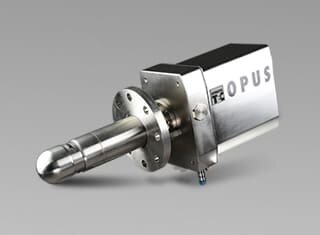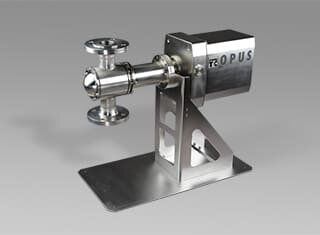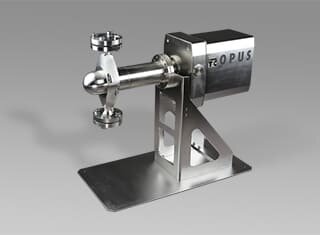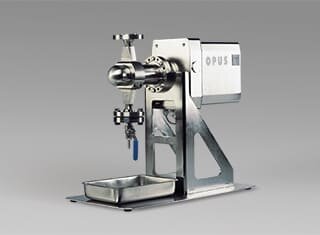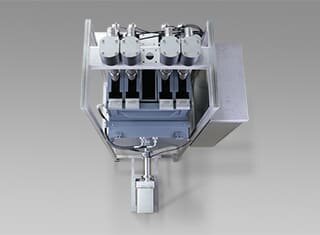Real-time particle size and concentration analysis in process environments from below 0.1 µm to 3,000 µm
The ultrasonic extinction spectrometer OPUS analyses particle size distribution as well as concentration of your suspension or emulsion ranging from below 1 µm to 3 mm. For many years, OPUS is successfully operating in crystallization, grinding and homogenization processes and proves its manifold performances. With various applications, OPUS is repeatedly revealing new insights – not only in production lines but also in pilot plants and lab settings.
Liquid dispersions with a high concentration of solid particles or droplets, often totally opaque, are typically found in production processes. Optical analysers would require a high degree of dilution. Dilution not only causes an extensive preparation effort but changes the original state of dispersion. Ultrasonic extinction provides an outstanding performance for particle size analysis of suspensions and emulsions. One of the major benefits of ultrasonic extinction is the ability to operate in highly concentrated mediums, which typically come along with wet process stages. A solid content between 5 and 50 % by volume is the typical range of concentration. These are perfect conditions for OPUS, which even may be applied at concentrations up to 70 % by volume – typical for paste-like particulate systems.
- Real-time in-line analysis of high concentrated suspensions, emulsions, slurries or pastes without dilution or sample manipulation
- Particle size and concentration ranging from < 0,1 µm to 3,000 µm
- Robust sensor for industrial processes up to 120°C | up to 40 bar | pH value 1-14 | IP65
- ATEX optional
- No moving parts
- Soft acoustic method without optical restrictions
- Simple to install and low-maintenance
- Powerful evaluation modes
Download more information about OPUS
Forgot your password?
Please enter your username or email address. Instructions for resetting the password will be immediately emailed to you.
Are you interested in additional content? Please register an account. After confirming the registration link brochures, application notes and other documents on particle measurement will be available for download.
OPUS Series
The process adaptation of OPUS to vessels or to large pipes is simple and typically uses a 100 mm adapter-flange (AF). For smaller pipes or bypass-lines, specific process adapters are available: e.g., flow-through (FT) or bypass (BP). The sensor may be positioned in a standby rack.
| Sensor | Type | Installation | Flow rate | Analysis volume |
|---|---|---|---|---|
| OPUS-FT | Flowthrough adapter | in pipes DN10 to DN25 | up to 2,000 l/h | 10-1,000 l/h |
| OPUS-BP | Bypass adapter | in pipes DN50 to DN200 | up to 10,000 l/h | 10-1,000 l/h |
| OPUS-AF | Flange adapter | in pipes >200 mm or in vessels | >10,000 l/h | 10-1,000 l/h |
| OPUS-MPX | Multiplexer | at up to 4 production lines | >20,000 l/h | 10-1,000 l/h |
Instead of electromagnetic waves (light), ultrasonic extinction applies low energetic sound waves. These waves are passing through a suspension or emulsion with 31 varying frequencies. For the introduction as well as the detection of sound waves, a piezo-electric RF-generator and detector set-up is used. The recorded loss of sound energy depends on the size and concentration of particles. A corresponding attenuation spectrum is determined and converted into a particle size distribution of 31 classes.
Using sound instead of light waves, ultrasonic extinction is independent of the level of transparency. Hence, totally opaque materials like ore slurries, water in crude oil or coke slurries, can be analysed. Furthermore, paints, sugar pastes, or pharmaceutical suspensions with high solids contents, rank as standard applications for the ultrasonic extinction principle.
In addition, the ultrasonic extinction method allows a rugged and robust probe design that resists typical process conditions. The OPUS probe masters temperatures up to 120°C, pressures up to 40 bar, the entire range of pH-value. It is resistant to aggressive media and abrasive materials. For applications in hazardous atmospheres, an ATEX compliant OPUS version is available.
The control and evaluation software provides calculation and display of all relevant and characteristic size distribution values. The OPUS system is fully compliant with FDA requirements and 21 CFR Rule 11. Adaptation to process control systems is natively supported by TCP/IP, Profibus, Modbus, digital or analogue PLC signals.



















